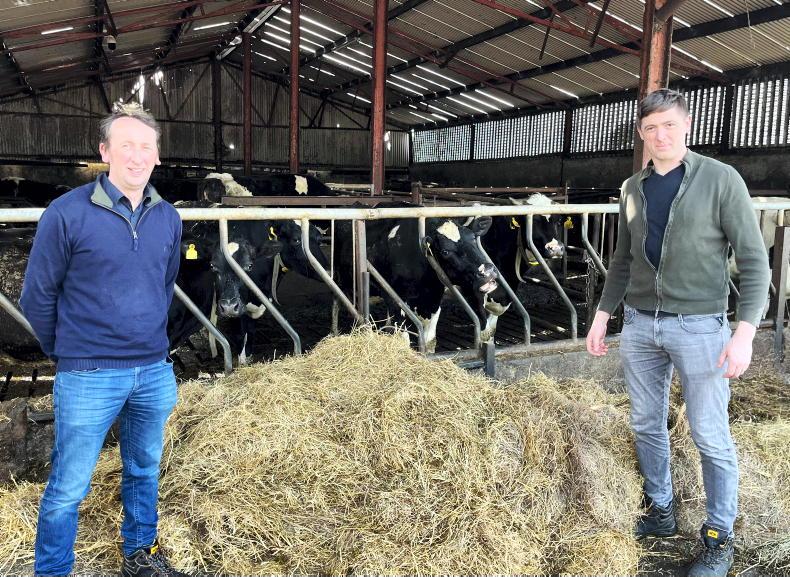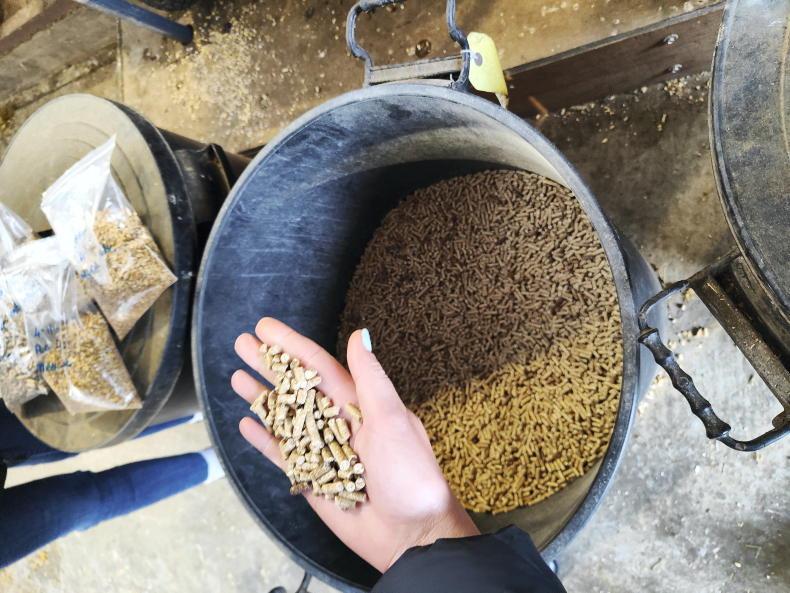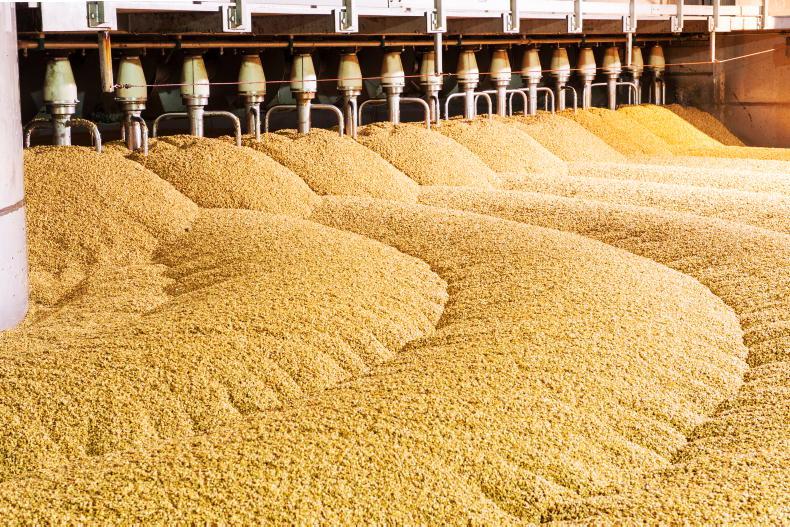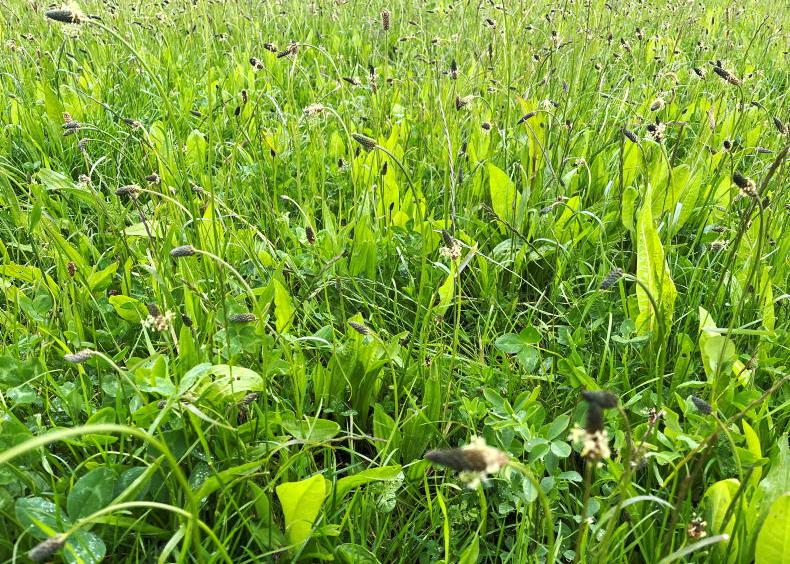Two methane-cutting additives developed by a Galway-based company could reduce agriculture’s emissions by 25% by 2030 if fully adopted, hitting the sector’s emissions target, say its founders.
The inventions – a pelleted feed additive and liquid or solid slurry additive – have been developed by the GlasPort Bio with support from Teagasc and the Department of Agriculture.
“By looking at the figures we’re getting in the trials, our slurry additive and our feed additive, you’re hitting your 25% reduction from agriculture in one fell swoop and even greater than that, to play a significant part in Ireland’s path towards its 2030 goals,” says co-founder Dr Ruairi Friel.
Speaking from the company’s base at the University of Galway, Dr Friel and fellow co-founders Prof Vincent O’Flaherty and Killian O’Briain explained how the products work.
The GlasPort Bio slurry additive has been proven to reduce methane emissions from slurry by 80% and will be rolled out to demonstration farms this summer. Its developers say it – as just one product – could reduce agriculture’s total emissions by 9% and Ireland’s overall national emissions by 3%.
Background
In slurry, micro-organisms break down organic matter and in doing so, release gases including methane, hydrogen sulphide and ammonia.
As the gases are released, they take important components of slurry’s nutrient attributes with them – carbon in the methane, nitrogen in the ammonia and sulphur in the hydrogen sulphide.
The gases released also create slurry’s smell and can become a health and safety hazard if encountered.
GlasPort Bio says its slurry additive ‘turns off’ the micro-organisms producing these gases, reducing methane emissions released into the atmosphere. In doing so, it keeps nutrient elements in the slurry, reduces its smell, makes it easier to agitate and reduces associated safety issues.
How does it work?
The liquid slurry additive is introduced, at a rate of 1-2l/t of slurry, through what Prof O’Flaherty suggested will be a fully automated system with an IBC-like tank, pipes and dosing nozzles. Piping is placed along the bottom of a slurry tank with dosing nozzles positioned every 4-5m.
For smaller farms, the slurry additive can be added in a block form similar to a mineral block lick.
Other microbial processes in the slurry, hydrolysis and fermentation continue un-inhibited.
“We’re not in any way disinfecting or sterilising the slurry,” Prof O’Flaherty said.

GlasPort Bio co-founder Dr Ruairi Friel (left) with field trial manager Dr Stephen Nolan.
The slurry additive is added every two to three weeks, depending on temperature and dry matter content. Colder conditions require less dosing with warmer temperatures, such as those maintained in a pig unit, requiring more.
“There’s a certain persistency of effect which means that even if there’s fresh slurry coming in over time, you don’t have to treat every day.
“This system records when you’ve dosed, that you’ve dosed and you can also link that dosing to a gas sensor so that the system can have an electronic nose, it can smell emissions and when they start to appear, it triggers the dosing,” explained Prof O’Flaherty.
Costs
Dr Friel maintained the slurry additive would be a “sound” economic investment for farmers and that the pumping system could be funded through TAMS and sustainability schemes.
The cost of the pumping system would be “in the low thousands” and the additive itself would cost something similar to fertiliser if refilling the tank, which would be required once or twice yearly, depending on herd size.
The GlasPort Bio slurry additive has been tested on pig and cattle farms and will roll out to 10 demonstration farms this year.
“Together with the recognition and acceptance of the terminology, national inventories, dairy processor environmental schemes and so on, you’d really start to see a rollout in earnest then into 2024 and beyond. By the time we get to 2030, there’s a well-established solution that’s on 100s of farms that people can see working really well,” Prof O’Flaherty said.
Results
On the farms trialled so far, the additive reduces methane emissions from the slurry by 80%, ammonia by 50% and hydrogen sulphide by 80%.
“We feel that that sort of 80% reduction is easy to achieve, it’s going to be cost-effective for the farmer even with no carbon-related payments. It will be something that is attractive for farmers to take on. We’re happy to hang our hat on an 80% reduction,” Prof O’Flaherty said.
Impact
According to the EPA, 11% of Ireland’s total agriculture emissions come from slurry
and, if all Irish beef, dairy and pig farmers used the
GlasPort Bio slurry additive, its developers say this would
generate a total emissions reduction of 9% for the farm sector.
“A 9% reduction is not to be sneezed at. Our [national agriculture] target is 25% and that’s an easy 9%,” said Prof O’Flaherty.
In a national context, Dr Friel says the additive could cut Ireland’s total emissions by 3%.
To do the equivalent of that in the transport sector he says “everyone is buying a €50,000 car and you’re going to have to get Government to roll out charging stations left right and centre.
“With this, you can say to your farmers – plug this in then press a button – and it’s done,” Dr Friel concluded.
A separate GlasPort Bio pelleted feed additive, RumenGlas, has been developed with trials showing a 30% reduction in bovine methane emissions.
Early sheep trials were completed in Teagasc Athenry, with a comprehensive beef trial completed at Teagasc Grange.

The pelleted RumenGlas feed additive developed by GlasPort Bio looks similar to a regular nut.
A pasture-based dairy trial will soon begin at Teagasc Moorepark and a pasture-based beef trial is in the works.
Background
Micro organisms in a cow’s stomach produce gases as they break down its food. These gases are released to the atmosphere and, in doing so, take energy with them. This happens faster than it does in slurry because the cow’s stomach is warmer.
Some 12% of the feed consumed by cattle is lost through energy in gases emitted. “Bugs producing methane steal the energy from the animal,” Dr Friel said.
Like its slurry additive, the GlasPort Bio feed additive alters the oxidation reduction potential (ORP) in the cow’s stomach, reducing emissions and saving energy, which in turn they say, leads to improved animal performance.
Additive
The powdered additive can be pelleted similar to a regular dairy nut, and could be mixed as part of any regular beef or dairy ration. Teagasc Grange trials, while indoor, were designed to model a pasture-based system. Cattle received a ration including the pellet twice daily, at a rate of 1-2% of dry matter intake, and their emissions were measured.
Unlike other methane-cutting feed additives, Prof O’Flaherty said GlasPort Bio’s product does not lead to an increase in hydrogen emissions from the animal as a side effect. This, he says, creates a positive animal performance response.
The finished cattle were found to emit 30% less methane daily, with blood and pathology tests carried out through to the human food chain. The methane-reduction power of the additive was found to persist for 10-12 hours post-feeding and a lag effect was seen for several days after the cattle had their last pellets.
RumenGlas would cost about €50 per cow, per year.
Dr Friel said they can see the feed additive working particularly well for dairy processor sustainability schemes where the pellets could be sold through co-ops. A once-a-day additive and bolus version are also in the works for smaller beef farmers. GlasPort Bio says the additive could be rolled out to farms by 2025.
Impact
Methane produced in cattle stomachs makes up half of all agricultural emissions, said Prof O’Flaherty.
He said that if the feed additive was used across the country, it could create an 18% cut in the farm sector’s overall emissions.
“You add the 9% [cut] from the slurry additive and suddenly, you’re in touching distance of [agriculture’s target] of the 25%.”
Next steps
While further trials continue, the GlasPort Bio pair say its products could be used on farms more quickly if more funding was made available.
The company says that if Government wanted to secure these farm emissions reductions, it could, and that if supported, upcoming pasture trials could all start together. “There’s a pathway to get it into the national inventories and our national emissions strategies and plans and reductions programme.
“In bringing something forward, we have the independent science, the verification, the publications – not just us saying it’s there. [It’s] validated, it’s done on real farms and that means that it’s not a pie in the sky because science isn’t and publications aren’t. Whatever ends up claimed in terms of emissions is actually delivered,” said Prof O’Flaherty.
Read more
Methane models over-estimate what Irish cows produce
Feed additive trials show 22% methane cut on forage diet
Two methane-cutting additives developed by a Galway-based company could reduce agriculture’s emissions by 25% by 2030 if fully adopted, hitting the sector’s emissions target, say its founders.
The inventions – a pelleted feed additive and liquid or solid slurry additive – have been developed by the GlasPort Bio with support from Teagasc and the Department of Agriculture.
“By looking at the figures we’re getting in the trials, our slurry additive and our feed additive, you’re hitting your 25% reduction from agriculture in one fell swoop and even greater than that, to play a significant part in Ireland’s path towards its 2030 goals,” says co-founder Dr Ruairi Friel.
Speaking from the company’s base at the University of Galway, Dr Friel and fellow co-founders Prof Vincent O’Flaherty and Killian O’Briain explained how the products work.
The GlasPort Bio slurry additive has been proven to reduce methane emissions from slurry by 80% and will be rolled out to demonstration farms this summer. Its developers say it – as just one product – could reduce agriculture’s total emissions by 9% and Ireland’s overall national emissions by 3%.
Background
In slurry, micro-organisms break down organic matter and in doing so, release gases including methane, hydrogen sulphide and ammonia.
As the gases are released, they take important components of slurry’s nutrient attributes with them – carbon in the methane, nitrogen in the ammonia and sulphur in the hydrogen sulphide.
The gases released also create slurry’s smell and can become a health and safety hazard if encountered.
GlasPort Bio says its slurry additive ‘turns off’ the micro-organisms producing these gases, reducing methane emissions released into the atmosphere. In doing so, it keeps nutrient elements in the slurry, reduces its smell, makes it easier to agitate and reduces associated safety issues.
How does it work?
The liquid slurry additive is introduced, at a rate of 1-2l/t of slurry, through what Prof O’Flaherty suggested will be a fully automated system with an IBC-like tank, pipes and dosing nozzles. Piping is placed along the bottom of a slurry tank with dosing nozzles positioned every 4-5m.
For smaller farms, the slurry additive can be added in a block form similar to a mineral block lick.
Other microbial processes in the slurry, hydrolysis and fermentation continue un-inhibited.
“We’re not in any way disinfecting or sterilising the slurry,” Prof O’Flaherty said.

GlasPort Bio co-founder Dr Ruairi Friel (left) with field trial manager Dr Stephen Nolan.
The slurry additive is added every two to three weeks, depending on temperature and dry matter content. Colder conditions require less dosing with warmer temperatures, such as those maintained in a pig unit, requiring more.
“There’s a certain persistency of effect which means that even if there’s fresh slurry coming in over time, you don’t have to treat every day.
“This system records when you’ve dosed, that you’ve dosed and you can also link that dosing to a gas sensor so that the system can have an electronic nose, it can smell emissions and when they start to appear, it triggers the dosing,” explained Prof O’Flaherty.
Costs
Dr Friel maintained the slurry additive would be a “sound” economic investment for farmers and that the pumping system could be funded through TAMS and sustainability schemes.
The cost of the pumping system would be “in the low thousands” and the additive itself would cost something similar to fertiliser if refilling the tank, which would be required once or twice yearly, depending on herd size.
The GlasPort Bio slurry additive has been tested on pig and cattle farms and will roll out to 10 demonstration farms this year.
“Together with the recognition and acceptance of the terminology, national inventories, dairy processor environmental schemes and so on, you’d really start to see a rollout in earnest then into 2024 and beyond. By the time we get to 2030, there’s a well-established solution that’s on 100s of farms that people can see working really well,” Prof O’Flaherty said.
Results
On the farms trialled so far, the additive reduces methane emissions from the slurry by 80%, ammonia by 50% and hydrogen sulphide by 80%.
“We feel that that sort of 80% reduction is easy to achieve, it’s going to be cost-effective for the farmer even with no carbon-related payments. It will be something that is attractive for farmers to take on. We’re happy to hang our hat on an 80% reduction,” Prof O’Flaherty said.
Impact
According to the EPA, 11% of Ireland’s total agriculture emissions come from slurry
and, if all Irish beef, dairy and pig farmers used the
GlasPort Bio slurry additive, its developers say this would
generate a total emissions reduction of 9% for the farm sector.
“A 9% reduction is not to be sneezed at. Our [national agriculture] target is 25% and that’s an easy 9%,” said Prof O’Flaherty.
In a national context, Dr Friel says the additive could cut Ireland’s total emissions by 3%.
To do the equivalent of that in the transport sector he says “everyone is buying a €50,000 car and you’re going to have to get Government to roll out charging stations left right and centre.
“With this, you can say to your farmers – plug this in then press a button – and it’s done,” Dr Friel concluded.
A separate GlasPort Bio pelleted feed additive, RumenGlas, has been developed with trials showing a 30% reduction in bovine methane emissions.
Early sheep trials were completed in Teagasc Athenry, with a comprehensive beef trial completed at Teagasc Grange.

The pelleted RumenGlas feed additive developed by GlasPort Bio looks similar to a regular nut.
A pasture-based dairy trial will soon begin at Teagasc Moorepark and a pasture-based beef trial is in the works.
Background
Micro organisms in a cow’s stomach produce gases as they break down its food. These gases are released to the atmosphere and, in doing so, take energy with them. This happens faster than it does in slurry because the cow’s stomach is warmer.
Some 12% of the feed consumed by cattle is lost through energy in gases emitted. “Bugs producing methane steal the energy from the animal,” Dr Friel said.
Like its slurry additive, the GlasPort Bio feed additive alters the oxidation reduction potential (ORP) in the cow’s stomach, reducing emissions and saving energy, which in turn they say, leads to improved animal performance.
Additive
The powdered additive can be pelleted similar to a regular dairy nut, and could be mixed as part of any regular beef or dairy ration. Teagasc Grange trials, while indoor, were designed to model a pasture-based system. Cattle received a ration including the pellet twice daily, at a rate of 1-2% of dry matter intake, and their emissions were measured.
Unlike other methane-cutting feed additives, Prof O’Flaherty said GlasPort Bio’s product does not lead to an increase in hydrogen emissions from the animal as a side effect. This, he says, creates a positive animal performance response.
The finished cattle were found to emit 30% less methane daily, with blood and pathology tests carried out through to the human food chain. The methane-reduction power of the additive was found to persist for 10-12 hours post-feeding and a lag effect was seen for several days after the cattle had their last pellets.
RumenGlas would cost about €50 per cow, per year.
Dr Friel said they can see the feed additive working particularly well for dairy processor sustainability schemes where the pellets could be sold through co-ops. A once-a-day additive and bolus version are also in the works for smaller beef farmers. GlasPort Bio says the additive could be rolled out to farms by 2025.
Impact
Methane produced in cattle stomachs makes up half of all agricultural emissions, said Prof O’Flaherty.
He said that if the feed additive was used across the country, it could create an 18% cut in the farm sector’s overall emissions.
“You add the 9% [cut] from the slurry additive and suddenly, you’re in touching distance of [agriculture’s target] of the 25%.”
Next steps
While further trials continue, the GlasPort Bio pair say its products could be used on farms more quickly if more funding was made available.
The company says that if Government wanted to secure these farm emissions reductions, it could, and that if supported, upcoming pasture trials could all start together. “There’s a pathway to get it into the national inventories and our national emissions strategies and plans and reductions programme.
“In bringing something forward, we have the independent science, the verification, the publications – not just us saying it’s there. [It’s] validated, it’s done on real farms and that means that it’s not a pie in the sky because science isn’t and publications aren’t. Whatever ends up claimed in terms of emissions is actually delivered,” said Prof O’Flaherty.
Read more
Methane models over-estimate what Irish cows produce
Feed additive trials show 22% methane cut on forage diet











SHARING OPTIONS